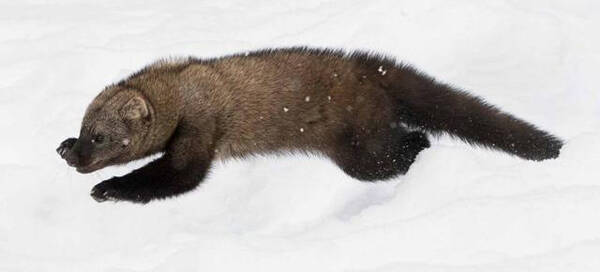Martes pennanti
IUCN
LCBasic Information
Scientific classification
- name:Martes pennanti
- Scientific Name:Martes pennanti,Fisher,Fishing cat, Pennant's marten, Pennant's cat
- Outline:Carnivora
- Family:mustelidae mustelinae marten
Vital signs
- length:75-120cm
- Weight:3.5-5kg
- lifetime:8-10years
Feature
It is shaped like a weasel and looks like a little bear.
Distribution and Habitat
Origin: Canada and the United States. Widely distributed in northern North America: from Quebec, the Maritimes, and New England west through northern Canada to southeastern Alaska, south through the western mountains to Utah, Wyoming, Idaho, and California, and once in southern Illinois, Indiana, Tennessee, and North Carolina. The southern range has declined, primarily due to habitat loss.
Inhabits temperate coniferous and mixed deciduous forests. Prefers habitats with high canopies. Prefers habitats with many hollow trees. Commonly found in wooded areas where trees include spruce, fir, white cedar, and some hardwoods. Also, their habitat preferences reflect the availability of local prey they depend on and prefer to eat.
Appearance
The fisher is similar in size to a weasel, with males being larger and heavier than females. The body length is 90-120 cm and the weight is 3500-5000 g. The female is 75-95 cm long and weighs 2000-2500 g. The tail of the male is 37-41 cm long and the tail of the female is 31-36 cm long. It has a shaggy tail, a pointed snout, and low-set round ears. There are 5 toes under the feet with retractable claws. The color of the fur ranges from light brown, medium brown to dark brown, with gold to silver on the head and shoulders, and black legs and tail. There may also be a cream patch of variable size and shape on the fur. Fur color and size vary by individual, sex, and season.
Details
Martes pennanti (scientific name: Martes pennanti) is also known as Fisher in English. There are 3 subspecies.

Martes use "resting places" such as logs, hollow trees, stumps, and nests on the ground at all times of the year. Underground burrows are most commonly used in winter, while tree nests are used year-round, mainly in spring and fall. In winter, fishers use snow dens, which are long, narrow tunnels under the snow. They are also agile swimmers.
They are active both day and night. In addition to eating small animals and carrion, they also eat fruit. Despite their name, fishers rarely eat fish, unless they steal fish caught by people. They hunt on the ground and in trees, chasing various rodents, including porcupines and other animals. They are one of several beasts that eat porcupines. They first tease the porcupine, then suddenly turn it over and slit its belly. Their diet also includes fleshy fruits and sometimes nuts.
The fisher is a rare carnivore in the boreal forests of North America. It is often trapped for its valuable light brown-black fur, and the fur of the female is particularly fine.
The breeding season of the fisher is winter and spring. It is a seasonal estrus animal, and the development of its sexual organs also has obvious seasonal cycle changes. From March to May. The gestation period is 338-358 days, including the delayed implantation of the fertilized egg into the uterine wall. After fertilization, the embryo suspends development for 10-11 months, and resumes development in winter after mating. The overall gestation will last nearly a full year, up to 11-12 months. The average litter is 3 pups, ranging from 1 to 6 pups per litter. Shortly after giving birth, the female will go into postpartum estrus again. Healthy females reproduce for the first time at the age of 1 year, produce their first litter of pups at the age of 2 years, and may reproduce every year. So females basically spend almost all of their adult lives in pregnancy or lactation. Males reproduce for the first time at the age of 2 years. Females reach adult weight at 5.5 months, while males reach adult weight after 1 year old.
The young minks of fishermen are born blind and almost naked. Each weighs about 40 grams. The eyes open after about 53 days. Weaning begins at 8-10 weeks, but may occasionally be raised for up to 4 months after birth. At 4 months old, the young minks are able to hunt and leave the group after at least one month. Most of the young minks live in hollow tree holes. If there is too much garbage, females will choose to move the young minks several times. Male fishermen do not participate in raising the young minks.
Listed in the 2016 IUCN Red List of Threatened Species ver3.1 - Least Concern (LC).
Protect wild animals and eliminate game.
Maintaining ecological balance is everyone's responsibility!








